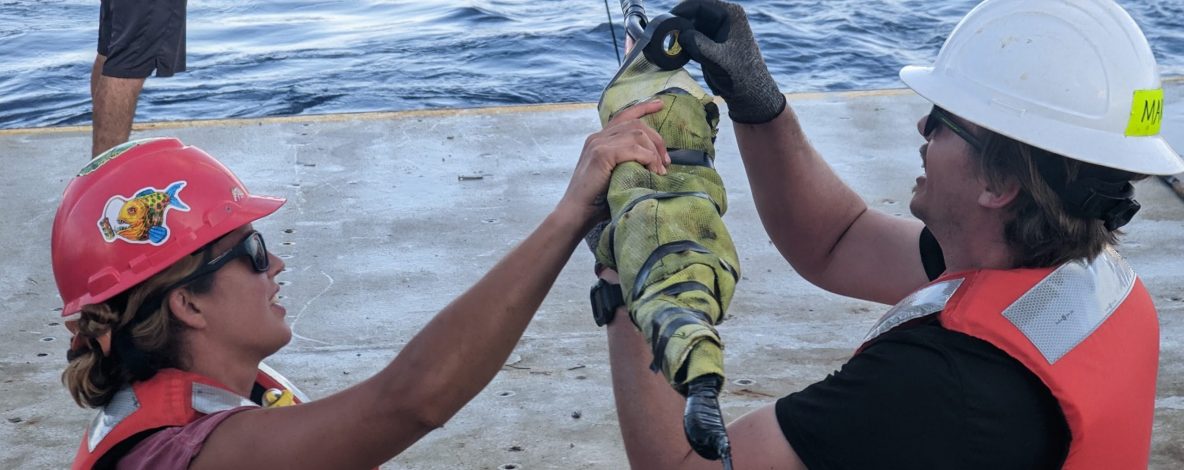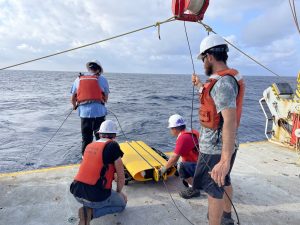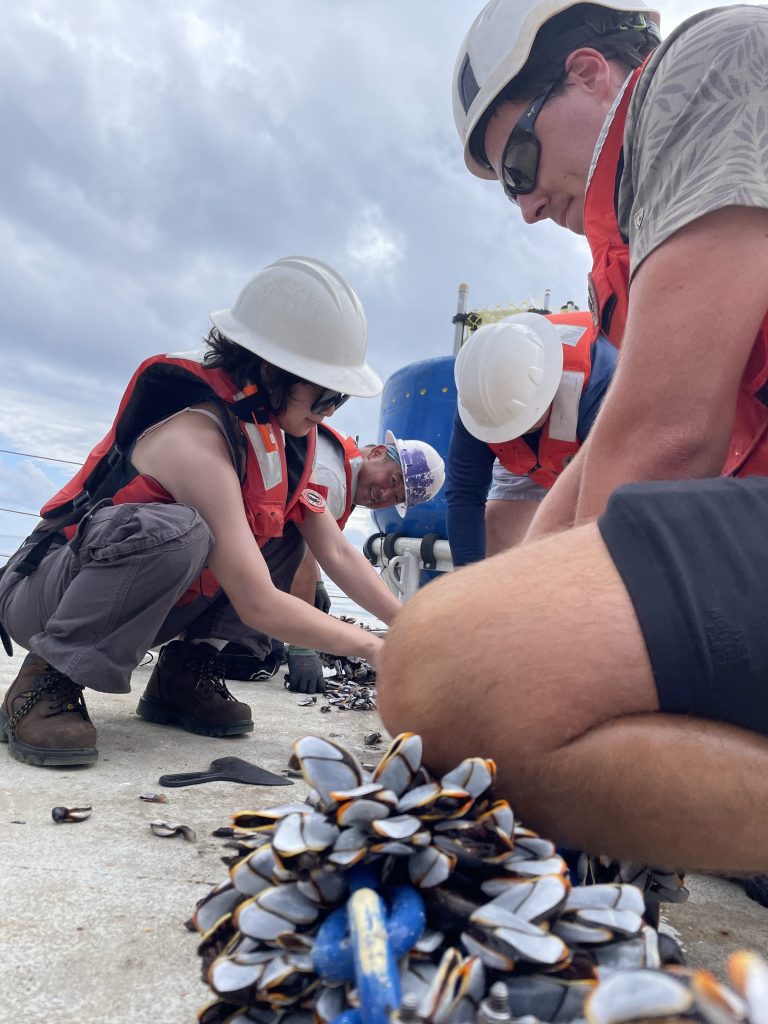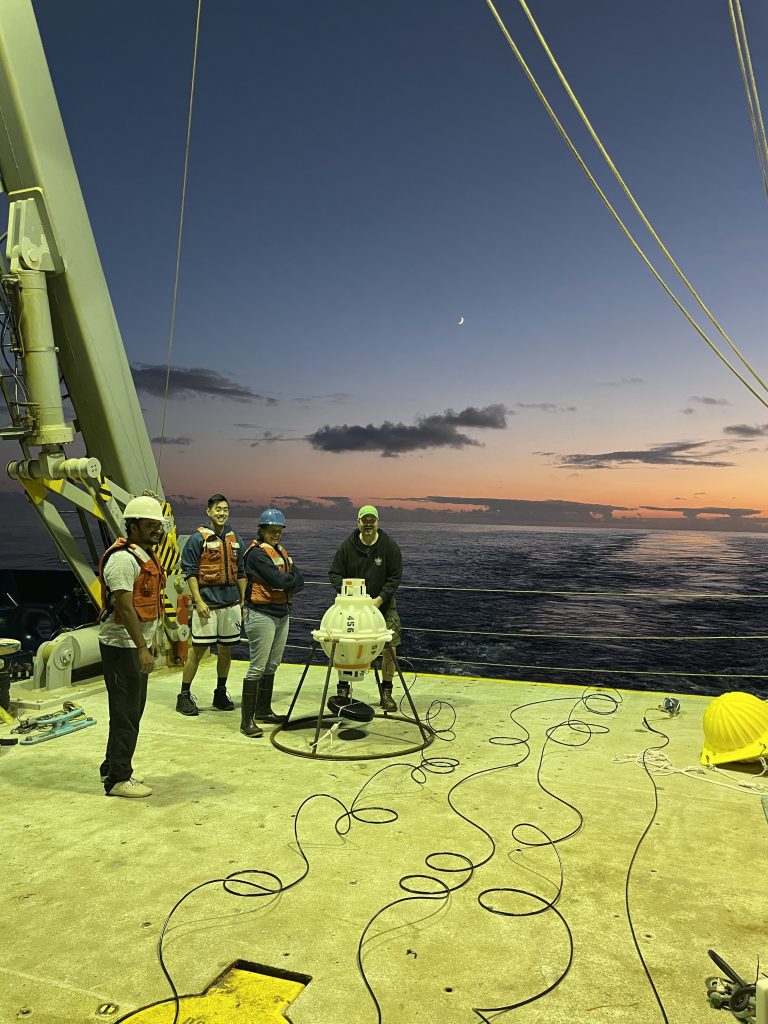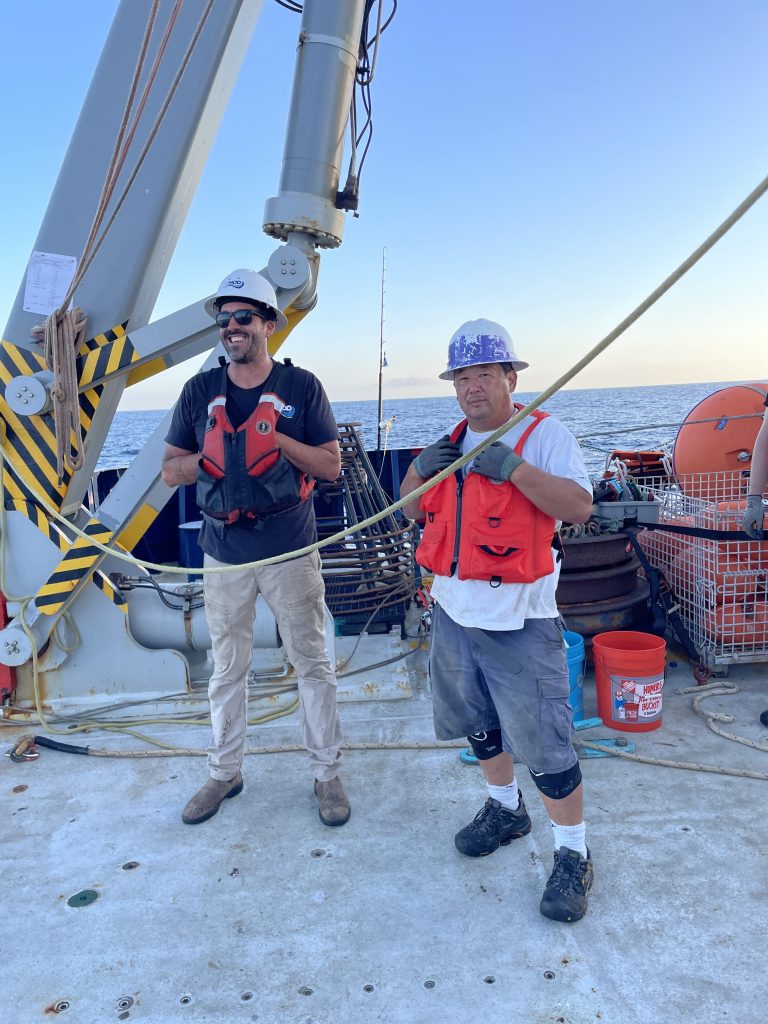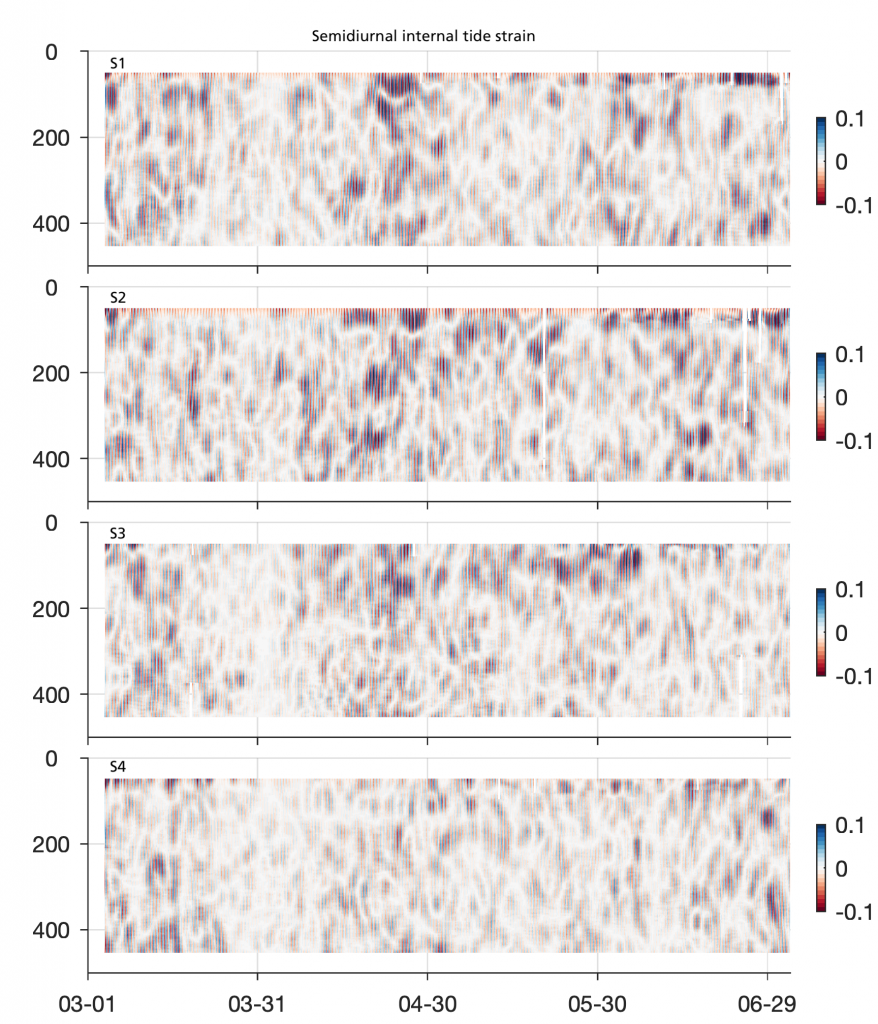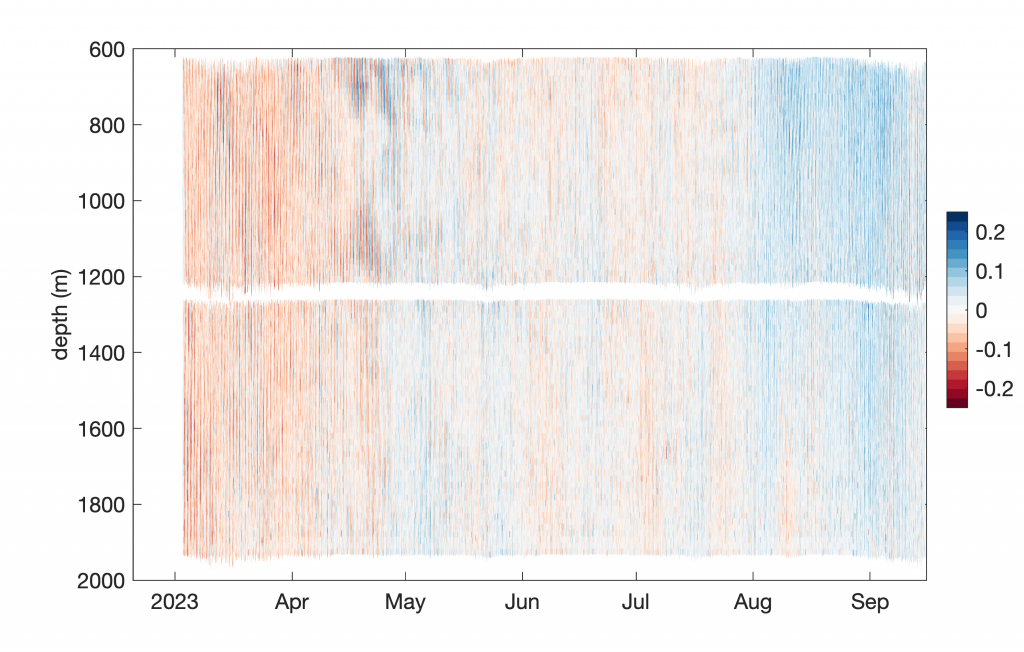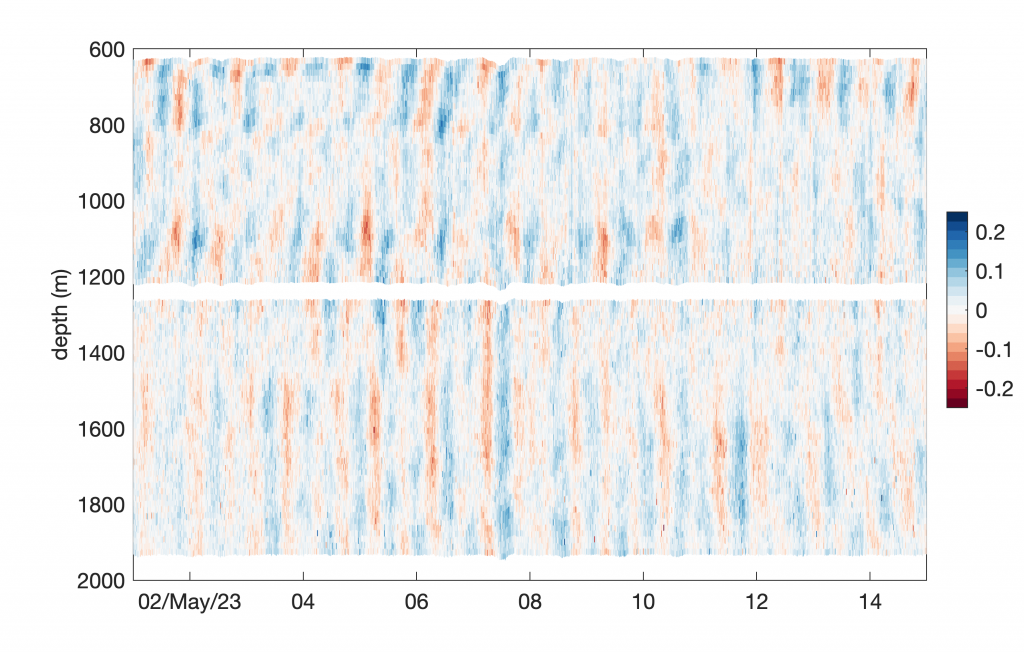
One of the big goals of the 2023 NOPP GIW field work was recovering and re-deploying the IWR mooring after a 200-day deployment as part of the SWOT Oceanographic Mission Cal/Val. anchordown
We developed the Scripps Hybrid Real-Time Mooring (HRTM) system for SWOT Cal/Val. The system combines a sub-surface taut mooring (600 m – 4500 m) with a ocean-wave-powered Wirewalker profiler (0-500m) and a surface buoy. Data from the moored instruments are telemetered to shore in real-time. The HRTM provides continuous vertical and time mapping of the upper 500m, and the vertical and temporal resolution from fixed sensors below necessary to measure the internal wave field over the entire water column.
Thanks to the NOPP-GIW program, we were able to incorporate velocity sensors and extra thermistors (see schematic on the right) into one of the four HRTMs deployed for the SWOT Cal/Val. This important addition allowed the measurement of ~full depth currents to complement the time resolved fluctuations of the density field at this location. While we have been at sea, several of our IWR team members have been attending the concurrent SWOT Science Team meeting in Toulouse, France presenting some highlights of our combined efforts.
We began the cruise by recovering the four moorings that had been deployed for almost 7 months. We were thrilled to find that each mooring performed as intended, with complete data records from all instruments. The Wirewalkers profiled continuously throughout the deployment, collecting ~35,000 profiles from the four moorings. Since these are round trip Wirewalker profiles from the surface to 500 m, this equates to 35,000 km traveled, or around the world at 30° latitude!
The vertical resolution of the Wirewalker temperature and salinity was <1 m, and the ~30 average time between profiles allows the full vertical and temporal structure of the internal wave field to be quantified over the upper 500 m for 7 months, at four locations.
- SIO Mooring team about the deploy the Wirewalker for another 7 months
- SIO Noah Howins prepping the Long Range ADCP for deployment
- SIO Mooring team preparing a subsurface float for deployment off the back of the Ride
All these data are publicly available on the JPL PO.DAAC website. We look forward to the new discoveries that will result when folks around the world dive into the data. This is especially exciting during the 1-day repeat orbit phase of the SWOT Cal/Val (April 4 – July 4, 2023), when the KaRin swath altimeter on SWOT overflew the mooring location twice per day.
- SIO Mooring team members Noah Howins, Cindy Tran and Spencer Kawamoto removing the gooseneck barnacles from the instrumentation
- WHOI Scientist Magdalena Andres and her PIES team deploying at sunset
- Chief Scientist & SIO / MAE Associate Professor Drew Lucas and SIO Engineer Spencer Kawamoto
Much of the data was delivered in real-time, so we have already been able to begin analysis of the internal tide signals in the area. In the upper 500 m, the internal tide strain field (the vertical derivative of the internal tide displacement) shows surprising incoherence between the closely spaced moorings, pointing to the complexity of the spatial variations in the internal tide at distances short than the expected internal tide wavelength of 100 km .
- Semidiurnal internal wave strain observed from the 4 x Wirewalkers
- Zoom in of the semidiurnal strain captured from the Wirewalkers
In the deep ocean, we were surprised to find strong tidal band currents down to at least 2000m. We also captured the deep geostrophic flow, presumably associated with the mesoscale eddy field in the California Current.
The mooring team (the Scripps Ocean Time-series group and the Scripps Multiscale Ocean Dynamics group) has been working hard out here, and yesterday we re-deployed the NOPP IWR mooring. The weather was pretty good, definitely better than the last time we were here in February, and the deployment went smoothly. Below you can watch the anchor drop operation, about 10 hours after we started deploying the 4.5 km (2.8 mile) long mooring. At the time of the anchor drop, the entire mooring was streamed out behind the ship on the surface.
As I write, the real-time data is streaming to the NOPP-GIW IWR mooring website. There, you can explore the real-time oceanographic conditions at the site, and the performance of the Wirewalker in real time. As an advance for this NOPP iteration, the ADCP and fixed velocity sensor data is also being streamed, in addition to the Wirewalker and fixed CTD measurements. In the future, systems like this will provide real-time data for assimilation into internal tide resolving models like HYCOM.

SIO Scientist Matthias Lankhorst and USM NOPP postdoc Dheeraj Varma collecting the crucial CTD calibration casts aboard the R/V Ride
The team is in good spirits. We have two more PIES to deploy to complete the array, including a real-time telemetering M-PIES at the mooring location. We also have some calibration casts with the ship CTD to make sure the mooring sensors are intercomparable. With continued favorable conditions, we expect to be steaming home this weekend.
–Drew Lucas, Chief Scientist, NOPP 2023 IWR Cruise, R/V Sally Ride

